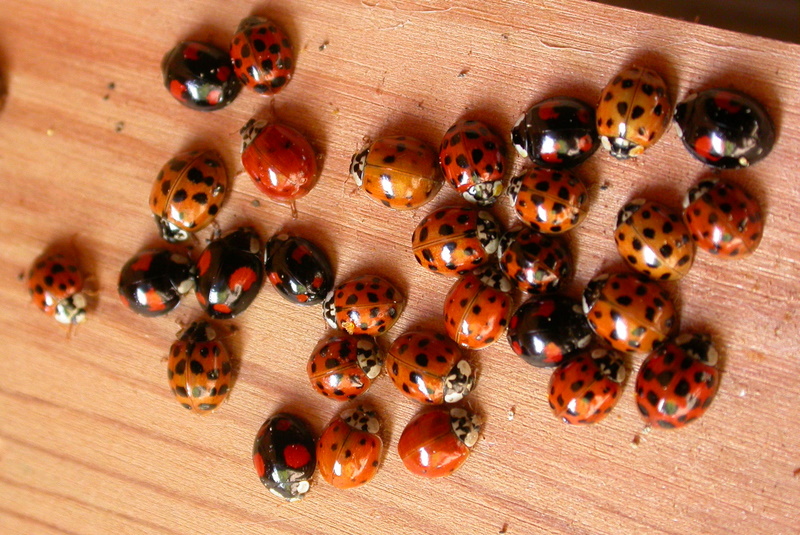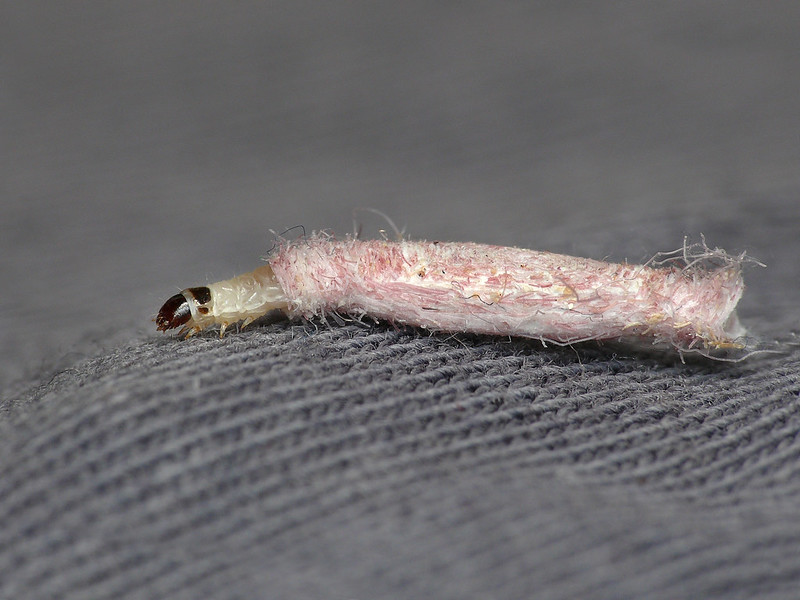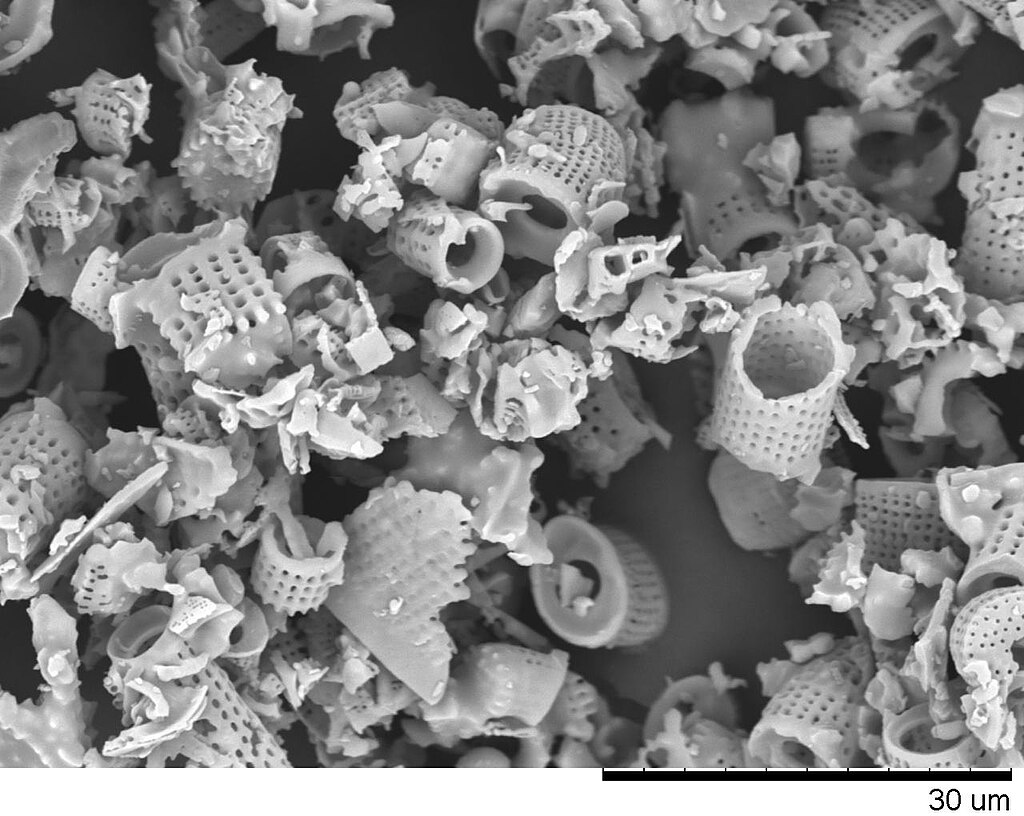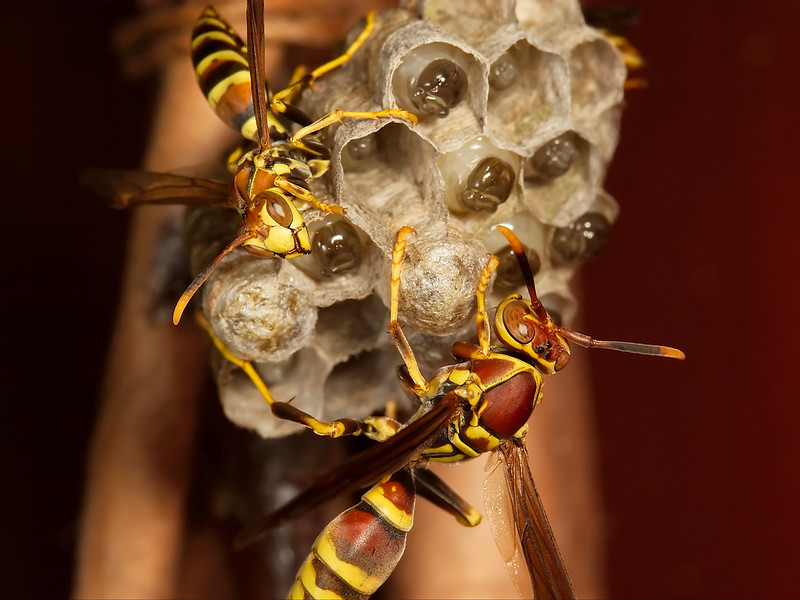As winter closes in around us, the flu is not the only bug we might be warding off. A host of insects, including stink bugs, seek the warmth of a house during the colder months. Although most of them are relatively harmless, they tend to be unwanted and irksome guests. What to do?
An insectophobe’s first instinct might be to break out the Raid; but poison comes with ramifications, and there are more responsible approaches to making your home comfortably free of insects.
Common indoor insect pests
Native insects are well-adapted to their climate, and have various overwintering strategies to survive the cold months. Unless they were in your house already, they are not likely to barge in just for the winter. Non-native species originating from warmer climates, however, have no way to survive our harsh winters and may seek refuge under the same roof as you.
For the most effective solution, get to know your pest.
Asian lady beetles

Easily mistaken for ladybugs (genus Hippodamia), Asian lady beetles (Harmonia axyridis) are an invasive species introduced to the US as agricultural pest control in the 1990’s. While they are champion aphid-eaters, their diet is not limited to pests, and they are quickly displacing our native ladybugs — not only via competition for food, but also as a predator. Once the most common ladybug across America, the convergent ladybug (Hippodamia convergens) is disappearing.
Success
You are now signed up for our newsletter
Success
Check your email to complete sign up
The Coccinellid family includes some 6,000 species of lady beetles of varied colors and spottage, and distinguishing the native from the invasive can be difficult; but any “ladybugs” that come indoors are most likely Asian lady beetles. Unable to survive our winters, they sneak inside, usually clustering by the windows.
If you have houseplants, they can help keep your green companions pest-free, but they have also been known to bite, leave yellow, smelly secretions on surfaces, and release pheromones that attract their friends.
If you choose to eradicate them for your own sake, or that of our native ladybugs, prevention goes a long way. Seal up cracks and crevices around your doors, windows, and siding. Chrysanthemums planted by your entrances are an effective repellent for these pests. Try to find hardy varieties that will last well into winter, or buy fresh, cut flowers to place indoors. Another botanical repellent is bay leaves — which can be placed in sachets near your entrances.
If you missed the window for prevention this season, you might be facing these wee visitors as we speak. Dusting your window sills with diatomaceous earth will injure their respiratory system and put an end to them. Another effective, non-toxic solution is to vacuum them up. Suck up some diatomaceous earth while you’re at it so they don’t crawl right back out.
Moths

Most of our native moths are beneficial pollinators that overwinter as pupae, in cozy, protective cocoons outdoors. Many moths in warmer climates don’t have a dormant period, and spend much of their life cycle as feeding larvae. Clothes moths and pantry moths, for instance, are active throughout the winter — consuming our favorite clothing and staple foods if they get the chance.
Clothes moths (Tineola bisselliella) are believed to have originated in Africa and spread to other countries via sailing ships in the 1800’s. They usually enter our homes as eggs, which can be nearly impossible to detect on textured fabrics like woolen knits. Cotton, silk, linen and other natural fibers are also susceptible to moth damage.
Used clothing and furniture, or those that have been stored in a dark, quiet space can carry moth eggs, so it is a good practice to give these items a good inspection and cleaning before incorporating them into your living space. Non-washables can be placed in the freezer for 72 hours to remove any threat. You might never encounter the actual moths, but if you start seeing unexplained holes in your clothing, it’s time to take action.
Empty the infested drawers or closet and wash each item according to its label. Vacuum thoroughly and wipe all surfaces with a vinegar solution.
To prevent future infestations, make sachets of cedarwood, lavender and rosemary to drive them away. Alternatively, apply small amounts of essential oils like lemongrass, peppermint, cinnamon or cloves to surfaces, wooden blocks or cotton balls within the wardrobe. These natural botanicals are much safer than mothballs for everyone except the moths.

Pantry moths, like the Indian meal moth (Plodia interpunctella), enter our kitchens, usually as eggs or larvae, on contaminated food items. Bulk grains and flours are especially susceptible, so inspect these items for evidence like webbing and tiny moving larvae. Any infected foods should be promptly removed from the home — straight to the curb in the trash (unless you have chickens who will happily take care of the problem).
Pantry moths, once established, can chew through packaging and infest other items — like cereals, dry fruits and nuts, pasta, pet food and powdered milk. As a means of prevention, store foods that aren’t consumed promptly in airtight containers, and wipe down your pantry shelves regularly. If you suspect activity with no visible evidence, placing the item in the freezer for a week will kill any eggs.
Like many insects, pantry moths are especially repelled by cedarwood and peppermint. These, along with select kitchen herbs and spices (bay leaves, thyme, rosemary, cinnamon) can be placed in small sachets in your cupboards. Their essential oils can also be used to make a spray solution to enhance your cleaning routine. Please note that these will not drive away an existing infestation, so it is important to first eliminate the pest in all its stages.

Stink bugs
The Pentatomidae family offers yet another pair of friend and foe cousins. The spined soldier bug (Podisus maculiventris) is a valuable predator of many agricultural pests. This North American native finds shelter in tree bark and leaf litter during harsh winters, and has little interest in moving in with us. Common across the eastern United States, it can remain active year-round in areas with mild winters.
The similar-looking brown marmorated stink bug (Halyomorpha Halys), on the other hand, is an invasive threat to many agricultural crops. It made its way to the US in the 1990’s, likely in an international shipping container from Asia. These pests are presently focused on the mid-Atlantic area where they have caused extensive damage to field, fruit, and vegetable crops.
Stink bugs are notorious intruders in the home. They seek warmth in the winter, and can flatten their shield-shaped bodies to squeeze through small cracks and crevices. They don’t do much indoors other than squat, mostly out of sight, waiting for spring to come with all its nourishing vegetation. On warm days, you will see them hanging around windows, like a pet wishing to go out.

Reminiscent of tiny, prehistoric warriors, their appearance may be startling, but stink bugs don’t bite, or even chew on things. When threatened, however, they will emit a stinky chemical compound that attracts more stink bugs. Thus, squashing or swatting at these pests is the most unproductive thing you can possibly do.
Stink bugs can be controlled with diatomaceous earth — sprinkled around windows, or other dark, hidden places where they like to camp out. Vacuum them up (dead or alive), but be sure to empty the canister outdoors.
Essential oils are also effective repellents against stink bugs. Clove, lemongrass and spearmint oil — or a mix of all three — will help keep them out of your home, as will careful maintenance in sealing up small openings around doors and windows.
Wasps

The vast majority of wasps are beneficial, both as pollinators and predators of other insects. Adults feed mainly on nectar or fruit juices, but must provide live prey for their larval offspring. With over one hundred thousand species, we are lucky to have only a few that commonly nest in homes.
The paper wasp (Polistes spp) looks similar to yellow jackets, but is quite docile in comparison. Unlike yellow jackets, who nest underground, paper wasps build nests in sheltered overhangs — like the eaves of a roof. This becomes a problem if they make their way into your living space.
Social wasps (like paper wasps, yellow jackets and hornets) have a unique survival strategy. Since they are not cold-hardy, most of them perish in the winter, so they do all they can to ensure that a queen survives to start a new colony in the spring. Queens, alone, have the ability to hibernate, but they can also lay specialized eggs to become new queens and males.
If you have wasps in your home in the winter, they are likely newly hatched queens, which may have emerged after a warm spell and accidentally migrated inwards towards warmth. As mentioned above, paper wasps are docile, but they will sting if stepped on or sat upon. They gravitate towards the light, so they can easily be captured off a window with a cup and a stiff piece of paper and safely released.
Paper wasps can build nests under the eaves, in air-conditioning units, and in attic gable vents. Winter is a good time to search and destroy, as they will be inactive. If you can’t find the source, you can prevent them from entering your living space by sealing any cracks and crevices in your ceiling and walls.
Essential oils like clove, lemongrass, and peppermint will repel wasps. They can also mask any scented communication from the previous generation indicating that your place is a good one for a nest.
Exterminators and traps
Should you have a serious wasp infestation, an exterminator is probably the best solution. It is now possible to find eco-friendly options. They will have all the equipment necessary to take care of a hidden nest and are not prohibitively expensive.
For serious infestations of stink bugs, lady beetles or moths, you can find non-toxic traps to help eradicate the problem before applying repellents and other preventative tactics.















